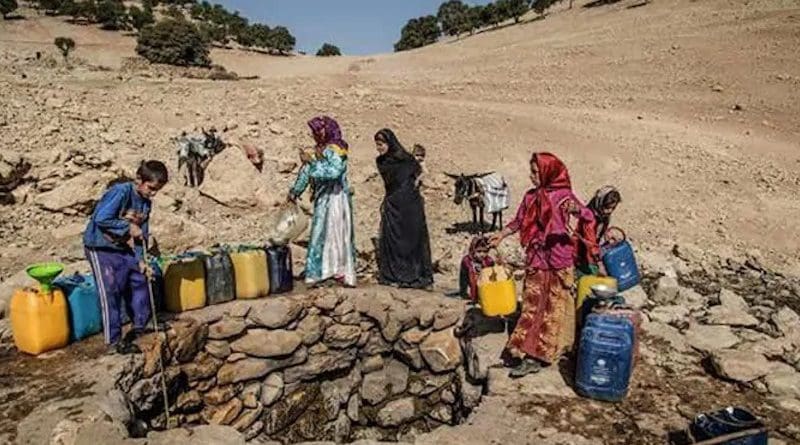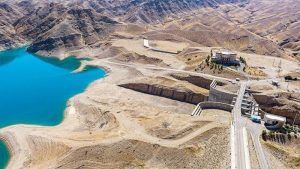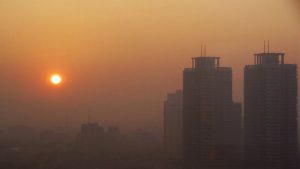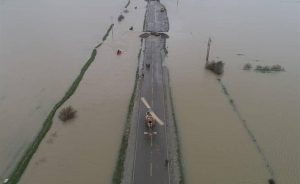Did Sanctions Cause Iran’s Environmental Problems? – Analysis
Economic sanctions are political instruments whose purpose is to isolate and hurt a target country’s economy, forcing policy revisions or bringing about political change. Although, the number of imposed international sanctions players like the EU and US have surged since the 1990s, the rationale of such punitive measures remains contested. Even worse, the unintended consequences of accumulating sanctions might inhibit the chances at meeting global climate goals as they can precipitate devastating environmental impacts. Also, in the short run, a target country may adopt alternative survivalist means to evade the grip of sanctions.
The debate on sanctions is too often centred around their political and economic ramifications. Responsible strategists should raise their environmental awareness beyond the immediately tangible gain when designing fiscally restrictive punitive instruments. Past experiences have shown that the imposition of sanctions carries significant unintended consequences for the environment and the climate in the short, medium, and especially the long-term.
What is often absent from discussions on sanctions is the impact they have on the targeted country’s environment? Academics working in this area acknowledge that sanctions are not the main cause of Iran’s environmental issues, nor do they directly lead to environmental degradation. Rather, sanctions have induced challenges that inadvertently act as “catalysts” for environmental issues within the country.
Beyond the challenges sanctions pose to conservation, the crackdown on Iranian environmentalists over the years has put Iranian conservationists and Iranian biodiversity at even greater peril. In January 2018, nine Iranian environmentalists were detained on charges of espionage, accused of using camera traps to undermine national security interests. One of the detained died in prison two weeks later under suspicious circumstances, while the rest were held incommunicado and denied due process for over a year.
Hardships resulted from both international sanctions and domestic government actions have affected Iranians. The Iran’s Clerical Regime ignored the warnings of Iranian environmental experts on its accelerated dam buildings and extensive ground water extraction. This effectively caused the disappearance of groundwater resources. The government routinely blames the deterioration of Iran’s natural ecosystems on climate change and insist that it is the result of other periodic factors such as droughts instead of its environmental policy changes. Today, Iranians are at the precipice of water crisis government mismanagement, a population boom and extreme corruption brought it on.
Prior to nationalization of water in Iran, it was a sustainable resource with 34 million Iranians relying on millennia old natural underground canals (qanats) and natural springs for their drinking water. This system has preserved aquifers in the country and maintained renewable water resources at 135 billion cubic meters. Now, with a population growth of more than 80 million and government supported infrastructure contributing to rapid water consumption, renewable resources are less than 80 billion cubic meters. This problem has contributed to the conflicts between the Clerical ruling class and the people. Water shortages, its delivery system and poor quality of drinking water are driving forces behind large scale violent protests. Many poor and frustrated Iranians are the first to see the effects of the water crisis.
The Iran’s Clerical Regime has accelerated the depletion of water resources in the hopes of expanding agricultural and infrastructure projects in pursuit of self-sufficiency. The agriculture sector claims more than 90% of the country’s water supply, leaving only a small percentage for other purposes.
The regime awarded huge dam building contracts to companies connected to those in power such as IRGC’s Khatam-al-Anbia and Mahab Ghoods. Also, encouraged farmers to grow crops no matter the level of water consumption. The extensive construction of dams blocked large and small rivers throughout the country and prevented aquifers from replenishing.
Sepasad, a subsidiary of Khatam-Al-Anbia conglomerate, became involved in major projects such as the Karkheh and Gotvand dams in Khuzestan Province, an area hit hard during the Iran-Iraq war and in dire need of assistance. It partnered with a prominent consulting firm under the regime’s Supreme Leader supervision, Mahab Ghodss. They started lobbying members of Parliament to push the government to build more dams. Mahab Ghodss designed and oversaw the dams, while Sepasad was the contractor. These two powerful bodies became gradually the core of what is now known as Iran’s “Water Mafia,” an entity that pushes for and wins projects, spreads the wealth among a small group of IIRGC members and individuals affiliated with the Supreme Leader’s compound. This entity is above the law and does not tolerate any critiques, accountability and efforts to monitor or audit its activities. This is how the cost of building a dam like Gotvand can increase from $1.5 billion to $3.3 billion, and nobody even dares to ask where all the money has gone while the contractor did such a poor job.
The Gotvand dam is an excellent example of the coordinated corruption and modus operandi of the Water Mafia. Iran’s Water and Power Resources Development Company handed the project to Mahab Ghodss and Sepasad. Even though geologists had warned them about a huge salt outcrop that was part of the Gachsaran formation where the dam was to be built, however, above mentioned entity decided to proceed with construction anyway, and created most noable Iran’s environmental crime without notifying the public that doing so could increase the salinity of the Karun River. Any prudent engineer would have refused to build a dam in a location where a multimillion-ton mass of salt would be part of the reservoir.
The question may arise that what IRGC, which is known for intervening in regional politics, sending fighters to Syria, Iraq, Yemen, Lebanon and threatening international shipping in the Persian Gulf, have to do with water management? The IRGC was created in 1979 to protect and export the Islamic revolution. In the years since it has been evolved into a significant military and financial player in its own right. It gets funding from the government for all kinds of major building projects, including oil, gas, petrochemical plants, dams, tunnels, and water transfer schemes. The IRGC’s tentacles now extend almost everywhere in Iran and it can force the administration to continue giving it bigger and more expensive projects. A large part of the country’s budget goes to water management projects, which are endless. From dam construction to water transfer schemes, the IRGC knows that it will forever control a significant portion of the national budget, and it protects its business interests using its intelligence organization. At the end of the day, it’s all about power and authority.
The mentioned situation forced Iranian farmers and other stakeholders to drill too many deeper wells into the depleting groundwater resources. As a result, the number of wells in existence since the 1979 revolution has multiplied by more than 13 times. Around half of the wells are illegal, which is far beyond sustainable. According to the deputy agriculture minister, the situation has created a negative feedback loop of government mandated, harmful infrastructure projects and unsustainable water consumption producing the current water crisis in Iran.
Extreme corruption at the highest level of the Iran’s Clerical Regime, severe mismanagement of allocated resources and close-minded approach to economic development has led to the massive depletion of Iran’s water supply and other natural resources over the past four decades. Although, it is a popular belief that the Shah started Iran down this path, even before 1979 but Clerics continued that path with more deteriorating speed. Today, the water crisis in Iran is especially poignant. Daily civil unrest against the corrupt Clerical Regime has brought this issue to both the national and international attention.
Aggressive development of water infrastructures and handing substantial subsidies to farmers were other examples of strategies developed under pressures caused by the 1980-88 Iraq-Iran war. The international sanctions and the resulting threats to national food security were reasons for an aggressive abuse of Iran’s natural resources. Iran is currently the third biggest dam builder in the world, also an over-user of its fossil groundwater sources, drying out major rivers, and destruction of wetlands. These are ironically happening in the country where the 1971 Ramsar Convention on the conservation of wetlands was signed.
Iran is currently dealing with a range of various environmental challenges. Water bankruptcy is the most recognized environmental problem of the country along with desertification, deforestation, overgrazing and air pollution. Rapid growth and improper spatial population distribution, economically inefficient and environmentally unsustainable agricultural growth and mismanagement of the water resources are the major factors of the country’s significant water problems, worsened by climatic variability and change.
Not only the Iranian environmental experts investigations but also even the Clerical Regime its own officials statements reveal that, the total water use exceeds the total renewable surface and ground water budget of the country. Non-renewable groundwater is being tapped and surface water is stored behind large dams and diverted through inter-basin water infrastructure systems to satisfy the growing water demand. Draining aquifers have led to declining groundwater levels. Excessive surface water consumption has significantly reduced river flows of Karun, Dez, Karkheh, Kor, Zayandeh-Rud, Qezelozan, Sefidrud and many other rivers, which subsequently destroyed numerous Iranian wetlands.
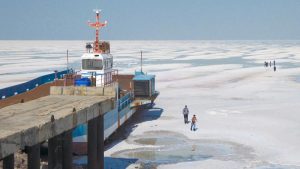
Lake Urmia, once one of the world’s largest hyper saline lakes has significantly shrunk. Its shrinkage is mainly due to the massive dams construction by IRGC, which has impacted whole watershed inflow of Lake Urmia as well as north-western region of Iran. Tragedy of Lake Urmia’s shrinkage is among the major symbols of environmental degradation in Iran. Other major wetlands around the country such as Hoor Al-Azim, Shadegan, Bakhtegan, Anzali, Jazmourian, Hamoun, Gavkhouni, and Parishan have also shrunk or completely disappeared due to reduced water inflows.
The water challenges of the country are not limited to water quantity problems but also its quality. Declining water availability in addition to the increasing biological and chemical pollution from agricultural activities, industrial, medical, domestic effluent and waste have resulted in water quality degradation in underground and surface water resources. This has made water unsuitable for various uses in some parts of the country. The Caspian Sea in the North and the Persian Gulf and Sea of Oman in the South are exposed to high levels of pollution from river discharges and human activities in the coastal zones of Iran and its neighboring countries.
Deforestation is on the rise due to ineffective laws, extreme corruption, multiple decision making authorities and lack of appropriate forest protection. Water availability, as it was already mentioned, is tremendously reduced due to massive dams construction and over extraction of fossil aquifers. Along with the above mentioned problems come sinkholes, landslides, over harvesting of forests, illegal logging, wildfires, urbanization, and the conversion of forestlands into agricultural and industrial sites. Deforestation, land use changes, reduced soil moisture, over-grazing, over-plowing, over-cropping, and poor land management practices have massively contributed to soil erosion, wildfires, flood damages, landslides and eventually desertification.
Dried wetlands, abandoned farms, land use changes, deforestation, soil erosion, and desertification have led to frequent dust and salt storms, threatening people’s health, causing significant damages to the ecosystem, reducing agricultural productivity, and increasing soil loss and the removal of valuable organic matter and soil nutrients. The declining levels of water in the aquifers due to the over-abstraction of groundwater have resulted in increasing land subsidence and the emergence of sinkholes in different parts of the country, threatening critical infrastructure.
Air quality degradation is amongst the major crisis in Iran’s large cities as well along with other environmental crisis. Rapid and unchecked urbanization, high population density, the poor quality and use of non-renewable energies, inefficient policies, aging fleet of gasoline and diesel vehicles, substandard emission control capacity of new vehicles, limited public transportation capacity and proximity to active industrial zones are among the typical causes of air pollution in Iran’s metropolitan areas. Tehran, Iran’s capital as most populated city is among the world’s top polluted megacities in terms of ambient PM10 levels.
Frequent dust storms are the cause of air pollution in some other parts of the country such as the Sistan and Baluchestan Province, one of Iran’s largest province by area in the Southeast, bordering Afghanistan and Pakistan, the Khuzestan Province, in the southwest of the country, bordering Iraq, as well as other provinces in the West such as Kermanshah, Kohgiluyeh and Boyer-Ahmad, and Kurdistan. These areas are exposed to the dust originating in Iran’s neighboring countries as well as the local dust sources produced as the result of drying wetlands, reduced soil moisture, deforestation, soil erosion, and desertification. Zabol was the world’s most polluted city in the World Health Organization (WHO) database in terms of PM2.5 levels, a city bordering Afghanistan in the Sistan and Baluchestan Province in 2016. The WHO database had four Iranian cities in the top ten most polluted cities of the world in terms of PM10 levels In 2011. At the time, Ahwaz, the capital of Khuzestan Province, was the world’s most polluted city in the world, followed by Sanandaj, the capital of Kurdistan Province, as third, Kermanshah, the capital of Kermanshah Province, as sixth, and Yasouj, the capital of Kohgiluyeh and Boyer-Ahmad Province, as ninth.
Air pollution is a major threat to public health and has immense economic, social, political and even security implications in Iran. Air quality degradation causes major damages to the ecosystem, infrastructure, cultural, historic and natural heritage sites. The economic damage of the morbidity and mortality associated with Tehran’s air pollution is estimated at 2.6 billion USD per year. This value excludes the economic cost of reduced economic activities, ecosystem service losses, infrastructure damages, quality of life, schools and universities closure (closing schools, universities, and even government offices is a strategy used by the government during days of extreme air pollution), and some other major indirect costs of air pollution.
Iran’s environmental problems have been exacerbated by extreme mismanagement, climatic variability, such as droughts and floods, which are common in Iran. Iran has historically been called land of droughts and floods, therefore, the Iranians have invented ingenue sustainable water harvesting system, qanat. However, frequent, long, and intense droughts in the past four decades along with incompetency, mismanagement, corruption and over extraction of groundwater has reduced water availability and the yield of rain-fed agriculture. Due to the Clerical Regime’s lack of proper flood control plans and its inactions, as they happen, not only massive floods weren’t harvested but also caused loss of many lives and massive economic damages. The result of such mismanagement and inactions were dying wetlands, decreased groundwater level, loss of fertile soil, erosions, desertification, and Natural ecosystem deterioration.
On the other hand, floods, especially flash floods, during the same period were more destructive due to vegetation loss, overgrazing and deforestation. Iran’s environmental crisis is according to many domestic and foreign ecology and ecosystem experts a Clerical Regime made crisis. Iran’s Clerical Regime and its officials insist to portray and connect it with the international sanction’s regime, droughts and climate fluctuations. However, according to clear facts stated in various paragraphs above, there is no agreement among scholars with a reasonable certainty on the level of the historical impacts of climate change and droughts. Nevertheless, most future projections portray warmer and drier conditions for Iran, which could further increase water shortage and ecological damages that could reduce agricultural productivity.
Moreover, it is predicted that climate change would increase the frequency and intensity of extreme events such as floods, droughts, heat waves, and wildfires. The ongoing environmental degradation in Iran also makes its people and ecosystem more vulnerable to future extreme events. The widespread, costly, and extreme flood events during the rule of Clerics, especially of Nowruz 2019 in Iran, which were unprecedented in the last decades, were a wakeup call about the high variability of climate norms, the possible consequences of climate change, and the high vulnerability of a nation that has significantly manipulated its ecosystem.
The sustained degradation of Iran’s environmental conditions is reflective of its unsustainable development efforts and plans, intending to develop the country without paying proper scientific attention to its natural ecosystem protection, potentials and the consequences of lasting environmental impacts. Now, those developments shortsightedness are causing major national security threats. Water shortage is affecting agricultural production, creating food insecurity risks.
Environmental degradation has also caused unemployment of farmers and fishers, poor living conditions and serious public health issues in certain areas, which are exposed to dust storms. These can potentially promote migration, marginalization, economic inequality, which subsequently leads to social instability, tensions, protests, and national security problems. Iran’s environmental problems certainly shouldn’t be tied to sanctions. These issues cannot be addressed without a fundamental change in Iran’s environmental governance institutions, management structure, and development plans, which these are an impossible task with existing regime.
Iran’s environmental problems reviewed above did evidently not arise overnight, but after decades of unsustainable management based on shortsighted development policies. Sanctions designed on Iran have never targeted humanitarian needs such as medicine, agricultural needs or environmental assistance. Sanction’s regime has targeted Iran’s adventurism, terrorism, human rights violators, nuclear, missiles activities and militarism.
Iran’s ruling officials and governing apparatus doctrine operate in complete antagonistic manner than general population. They have no respect for Iranians Human rights and well being of the citizens. They categorically violate the basic rights of people and are seriously concerned about their existence. Thus for, the ruling Clerics are only concerned to feed their oppression institutions and let them plunder Iran’s wealth without any care to protect Natural Ecosystems.
As observers have clearly seen Iran’s position towards its ban on WHO approved vaccine, which such decision has caused huge casualties of Iranians, the same attitude exists towards environmental conservation. Therefore, recognizing sanctions as the root cause, as done by some Iranian officials, its league of scientists, apologists and lobbyists is not justified. Just as with climate change, sanctions are not the driver or cause of Iran’s current environmental problems but the Regime’s own missteps.
* Khalil Khani holds a Ph.D. in Ecology, Botany, and Environmental Studies from Germany and has taught at the University of Tehran and the Hesse State University in Germany. He is also a Doctor of Medical Psychology from the United States.

